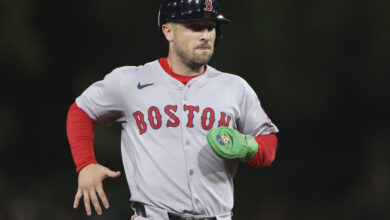
A Look at Reliever Usage by the Cubs and if Changing Reliever Rules Could Benefit The Team
On Wednesday, ESPN’s Buster Olney proposed a rule change that would limit managers to no more than four pitchers per 9-inning game. Among his goals are to shorten games, protect bullpen arms and end the effective but boring parade of relievers at the end of games.
The story attracted hundreds of readers’ comments and much comment in other forums. Whether you love or hate the idea, it could actually benefit the Cubs. And this is because, in his time in Chicago, Joe Maddon has shown a tendency to lean heavily on his bullpen, leaving them somewhat depleted once October comes around.
Last year alone, Maddon used nearly 10 percent more relievers per relief inning than the average NL playoff team. This regular-season burn rate has required the Cubs to regularly trade not just for playoff reinforcements, but simply for fresh replacement arms to handle the key high-leverage innings.
The prospect cost has been steep. In 2016 and 2017, Theo Epstein traded seven prospects and one swingman (Adam Warren) for four relievers. The approach paid off in 2016 when newly acquired Mike Montgomery and Aroldis Chapman combined to handle more than half of all playoff relief innings (30 of 58.2 innings). This included 10 of 12 relief innings in the team’s four World Series wins.
During 2017, the front office traded for a full season of Wade Davis. By nursing Davis’ regular-season innings, Davis shouldered the extra-heavy playoff workload, but trading for Justin Wilson to play the Montgomery role did not pan out and he could not be trusted come playoff time.
So Maddon rolled the dice with Carl Edwards Jr., who had appeared in 73 regular season games (45% of all Cubs games). Add in Edwards pitching in 7-out-10 playoff games, and he was clearly beyond an optimal workload. It also didn’t help that Edwards faced the Nationals’ two best hitters – Bryce Harper and Anthony Rendon – four times in five games.

This year, to avoid giving up prospects, the front office used free agency to find two new end-of-game relievers. However, workload is already an issue with both. Brandon Morrow has appeared in 41% of all games (25 appearances). That puts him on pace for 66 appearances this season, which has already included throwing three consecutive days against the Mets.
With the second free agent Steve Cishek, Maddon is testing every bit of elasticity in the side-armer’s rubber arm. Cishek has so far appeared in half of the Cubs games. At this pace, he could finish just shy of the team record of 84 appearances, set by Ted Abernathy (1965), Dick Tidrow (1980) and Bob Howry (2006).
Factor in that four other relievers are also on pace for more than 65 appearances. They are Wilson, Pedro Strop, Brian Duensing and Edwards (currently on the 10-day DL). No matter how effective they have been to date, one must wonder – as in the past two years – how much will be left in their tanks for a full extra month of playoff games.
Maddon started the season with two long relievers yet neither Montgomery or Eddie Butler have really been utilized in that role, except when pressed by extra innings. Of course, it doesn’t help that Butler has been on the DL since April 20 and Montgomery has had to fill in as a starter to cover for an injured Yu Darvish.
Only five times in a regulation 9-inning game has Montgomery thrown more than one inning in relief. Butler did so just twice before going on the DL. Compare this to the Cubs’ last true long reliever – Carlos Villanueva. In 2014, he pitched two innings or more 17 times. The year before, Villanueva made 15 starts but still had 9 of 32 relief appearances that were two innings or more.
Given bullpen usage so far this season, as we move gradually closer to the July 31 trade deadline, it’s fair to speculate whether the Cubs will again need to invest its limited trade chips to get replacement relievers. If that happens, it could crowd out any fantasies about going after Manny Machado.
Either way, you can expect the front office to closely watch available closers and set-up men with an eye towards perhaps acquiring one or two. Promoting Adbert Alzolay to the second half bullpen could be an option, and rehabbing Drew Smyly has just started throwing. However, Smyley hasn’t pitched competitively since 2016. So a definitive decision on what his second-half contributions can be could be difficult before July 31.

